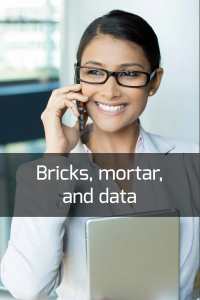Bricks & mortar and data – How BuiltSpace is transforming real estate with digital twins

 Digital twins create digital images of physical assets to transform business processes. These processes are measured and managed on the BuiltSpace platform.
Digital twins create digital images of physical assets to transform business processes. These processes are measured and managed on the BuiltSpace platform.
Deloitte describes “digital twin” technology as “a near-real-time digital image of a physical object or process that helps optimize business performance.” The digital twin creates a data repository for current and historical data, for an asset, that can be integrated into business processes. This data may be derived from the asset itself, or from people using, operating or maintaining the asset. As Deloitte says, this data too should be near-real-time.
Indeed, the real power of a digital twin—and why it could matter so much—is that it can provide a near-real-time comprehensive linkage between the physical and digital worlds. Deloitte
So, what’s the value of linking physical and digital buildings with near-real-time data? It’s probably not what you think.
First, it’s not (primarily) about energy!
When people think about creating digital buildings, they usually go straight to monitoring energy consumption, and trying to eke out a return on investment from energy savings. I’m not saying that this can’t be done, I’m saying that there are better targets, with much less investment, and much higher returns, without costly engineering and the installation of monitoring hardware in individual buildings.
Digital twins save labour and improve asset utilization
After property taxes, labour is the second largest expense line item for most real estate operators, and most of those costs are passed through to tenants. Both landlords and tenants would like to see operational efficiencies in order to be more competitive, in an increasingly competitive marketplace.
Digital twins provide a platform for the collaborative digitization of business processes, to automate these processes and reduce management, administration, and field service labour across enterprise boundaries.
For the front-of-the-house (for real estate operators), this digitization streamlines the delivery of services to tenants and guests, providing them with real-time metrics on revenue opportunities and operating costs. Better data adds value to the physical real estate, and keeps tenants engaged.
For back-of-the-house services, digital buildings provide better information about buildings, enabling field service technicians to resolve problems more quickly and in a single visit. Open transactions are resolved in hours rather than days, saving administrative and management costs on both sides of each transaction. The potential savings, measured in real time, are 30 percent or more.
Better data, better utilization of assets, and savings form improved processes, creates a bigger wallet, with savings shared by landlords, tenants and service vendors. Deloitte describes this as:
Collaboration Increases Share of Wallet
In a tight economy, new accounts can be increasingly difficult to secure, even in emerging markets. As a result, suppliers are increasingly targeting their sales efforts to existing customers and can only succeed if they add value above and beyond their competitors. While price is important, competing on price alone often leads to fickle customers who, a year after of doing business with you, will leave to find cheaper pastures.
The efficiency gains from digitization are real, and measureable in real-time.
Efficiently delivering services to tenants and guests
By enriching the physical environment with real-time metrics on what’s happening in individual buildings or spaces, landlords and tenants can better utilize their real estate assets, and compete with online competitors. For landlords, this adds value, resulting in higher over all utilization and revenues. For tenants, metrics allow them to optimize their physical space requirements, and control their costs.
Efficiently managing suppliers and service providers
In the back of the house, landlords and tenants also need to streamline the delivery of services to their physical facilities, and better measure actual service delivery costs in real-time. For tenants, operating costs, largely from the delivery of back of the house services, equal or exceed rent. Both landlords and tenants are hindered by lack of visibility to the true costs of services. Tenants want better information so they can control their operating costs. Landlords want to be more competitive in their markets. Lower costs are a win-win.
Service providers too are hindered by poor processes. In many cases they arrive on site, asked to fix a problem in the building, but have little or no insight into the equipment, systems or past service history. Digital twins provide these service providers access to this information, reducing on-site field time, and additional truck rolls. Service providers can measure savings of 20-30 percent, reducing their on-site time by $100 per invoice or more, based solely on having better data available. If they knock an hour off of their service call, they arrive at the next job an hour earlier. Installing the same parts in less time means their profitability skyrockets. They too win from better processes.
Real-time exchange of service transactions between the service provider and his/her customer creates provenance for each transactions, enabling the customer to see, measure and approve work as it’s completed. Service cycles are shortened from months to hours. Landlords gain control of their shrinking (and measured) service costs. Tenants too share this provenance for service interventions, visibility to improved sustainability, and lower operating costs.
With shorter cycles, fewer transactions remain open, less time is spent on administration of these transactions, on both sides of each transaction.
With services measured in real-time, real estate operators can replace awkward “request for bid” and “purchase order approval” procedures with much more efficient online delivery of services, measured in real-time. Landlords, and tenants, get what they pay for. Service providers, too, share in the efficiency gains from digital twins. Everybody wins.
BuiltSpace is the leader in digital building twins
BuiltSpace, today, is managing digitally twin for over 14,000 buildings and 100,000 individual pieces of equipment within these buildings, all makes, all manufacturers, and all vintages.
We provide collaborative service processes that allow service providers and real estate operators to work together in real-time. Our cloud-based platform is transforming real estate operations to dramatically reduce operating costs and increase asset value. For a personal invite to our platform contact me personally. You can start building digital twins at no charge.
You can reach me at rick@builtspace.com, or by telephone at 604.398.6035. I look forward to talking to you.
Rick
